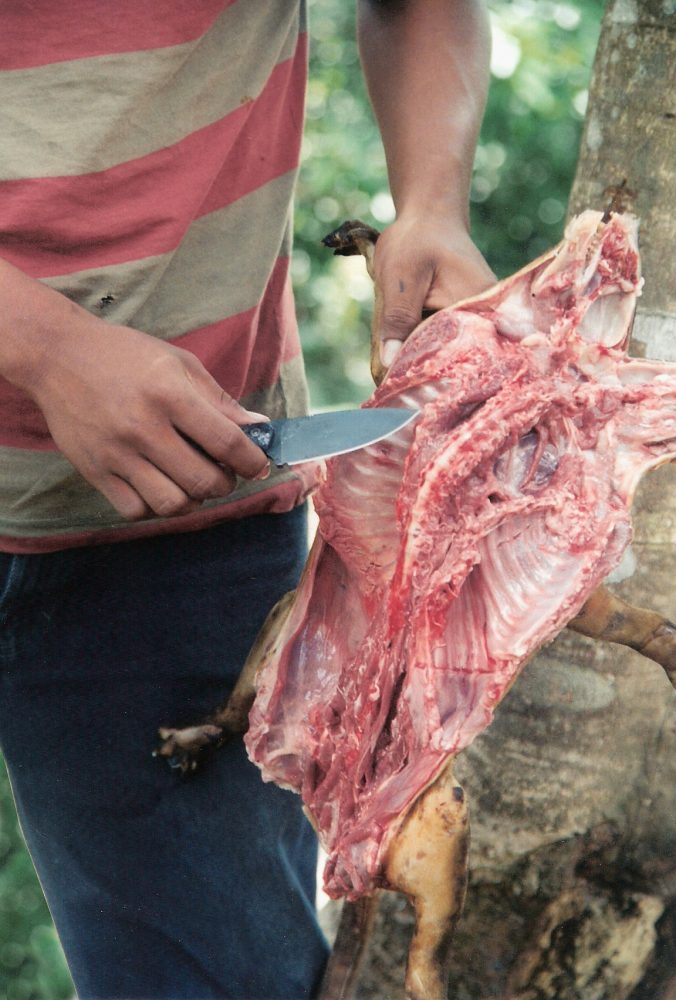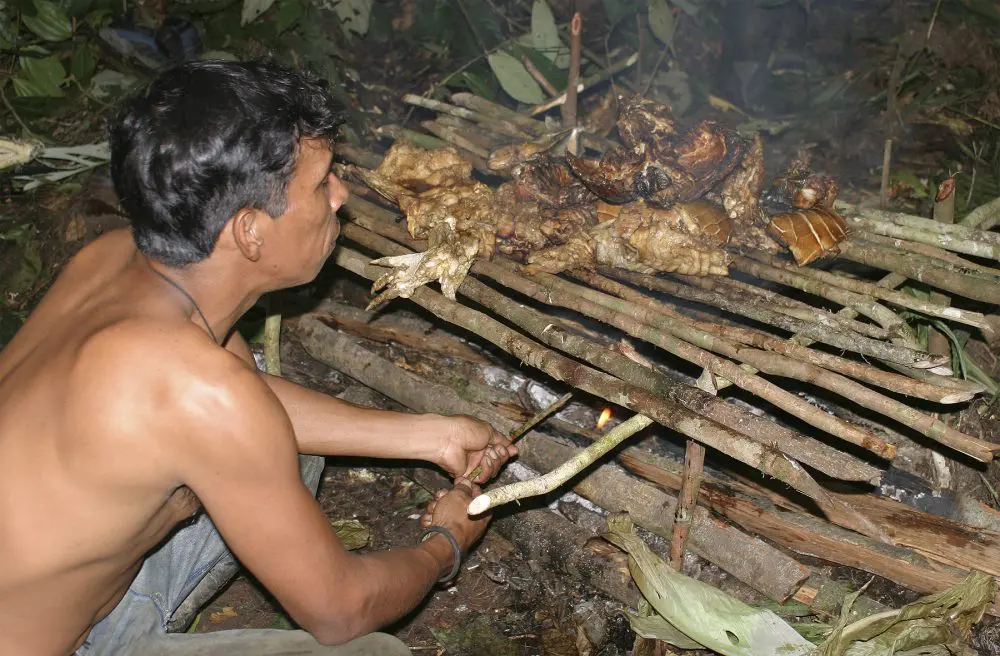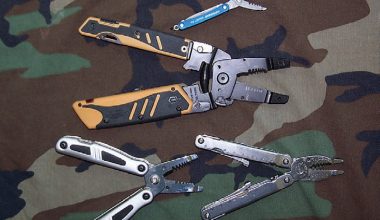Smoking meat over a cook fire is an easy way to temporarily preserve it for later use.
I finally watched my first episode of the survival series Man vs. Wild. I wasn’t impressed.
While there were a few sound survival tips in the program, I chuckled to myself when the host said he could die if he didn’t get food—and this was only his second day in the bush. Later in the program the star of the show grabbed a small water snake, bit it in half and swallowed everything but the head. That was enough hype for me to discredit any content value the show had. Not because eating a snake is bad for you, but the minimal nourishment received is not worth the potential of stomach problems, especially when two days without food is not considered “dire” by any stretch of the imagination.

I’ve gone for several days without eating in the bush and when you finally get the chance to eat, your stomach has changed. Just about anything you put in it, especially raw meat, causes it to react in strange ways, and you may end up spending a few uncomfortable hours until the digestive process catches up. Trust me, there’s nothing more miserable in the bush than that sinking, nauseating feeling of diarrhea. If you must eat, it is always better to cook raw meat and then eat a little bit at a time instead of gorging yourself right off the bat. The hungry stomach does much better when the meat fibers and proteins have been broken down from a cook fire.
Foraging for edible plants can also be a problem, since there is no absolute way to determine edibility if you’re unfamiliar with the plant. Even the “Edibility Test” from the U.S. Army Survival Field Manual is “iffy” at best. Using this method could potentially poison someone who would otherwise just go hungry for a few days. Edibility tests should only be used as a last resort once the survival situation has been determined to be long term. [Editor’s Note: The manual that includes the “Edibility Test” can be downloaded in PDF format at www.equipped.org/multiservice_ser_manual_1999.pdf]
Another common falsehood that runs rampant in survival lore is being able to consume whatever the animals eat. This is also bad ju-ju. For example, squirrels in the Southeastern part of the United States regularly eat Buckeyes, which are poisonous to humans, and some monkeys in South America eat fruits that contain cyanide.
Simple box trap made from small sticks and lashing vines found in the wilds.
I guess the question on the reader’s mind at this point is: how do I know if my survival situation is going to be long term and require me to hunt for food? You don’t, but statistics have proven that people in survival situations die from a myriad of other things long before they die from starvation. Cold, heat, dehydration, injury and generally succumbing to the elements will put you into rigor mortis long before hunger will. So unless you are sure about your situation and the surrounding wild foods, then the best advice is to avoid the potential of poisoning or becoming sick to your stomach simply because you’ve gone a couple of days without food. Eating, for most folks and most survival situations, is just not that important, since the human body can survive many days without proper nourishment. True, once the caloric intake falls, strength and stamina decrease, but the body is still mobile and the mind can still think rationally, unlike going without water. Using wild foraging as a way to stay comfortably fed takes a lot of study and practice with knowledgeable instructors.
Survival student prepares small Caiman for dinner. Gator was trapped at night during author’s survival training class.
Another point to consider about foraging is that, once the region changes, it’s likely the plant, animal and fish life will change also, so knowing your own region may not always translate to different environments. If part of your survival plan includes the ability to hunt and gather, then at least carry a regional guide book that absolutely identifies what you’re about to put in your mouth.
If you do find yourself in the role of Tom Hanks in Cast Away and have to hunt and gather to survive, then avoid searching for foods with low food value that are not easily gathered in sufficient quantities, otherwise it may take more energy to gather the food than the nutritional value will replace. Although not always possible, my philosophy in the wilds is: bigger is better. If I can catch a big fish, I can eat on it for several days, even if I have to smoke part of it to preserve it. If I’m living on tadpoles and minnows, I’m going to be expending a lot more energy to stay fed.

Also, don’t rule out insects as a way to gather nutrition on the move. As with plants, you have to know what you’re eating, but a lot of insects have a very high nutritional value. The large grubs found in rotting Central American palm trees have become our survival school’s trademark “fast food” when we’re on the trail.
In my opinion, one of the easiest food sources for most wilderness areas is the ability to fish and trap. Of course this takes practice and a few tools to be successful, so unless you’ve practiced making these tools from the forest, then be sure to carry a personal survival kit. Even if the kit contains nothing more than a few fishhooks of various sizes and a spool of line, these two items will allow you to catch fish, birds and small mammals without much of a learning curve. I know a couple of “hunters” who have snagged wild turkeys by suspending fishhooks from trees baited with a piece of corn. When the hook is placed slightly higher than the turkey can reach, they will jump up and snag themselves while trying to get the bait. While this may not be the most humane way to get meat, the first rule of survival is, “There are no rules.”
Another good addition to the wilderness survival kit is a gill net. They’re cheap, lightweight and pack up to about the size of a baseball. Stretched across small creeks, they can feed you without much energy expended. I’ve also caught large fish and turtles using trot lines (multiple hooks suspended in the water) and single “bush hooks,” which is nothing more than a large fishhook baited with a piece of meat, dropped in the water and tied off to an overhanging tree or bush along the bank.
Small box traps can be made by lashing four sticks in a square with vines, then lashing more “squares” on top, with each square being slightly smaller than the previous one. When you’re finished, you have a cage that looks like a pyramid. These can be set using simple triggers and baited with fish guts, grains, wild fruits or anything else available.
Some of the more “extreme” traps we have used in the jungle have been huge deadfalls and spring traps armed with sharpened sticks and located close to animal trails. We’ve also taken large game with a “trap gun” made from a hunter’s 16-gauge shotgun and lashed to a tree with trigger trip wires (vines) placed across a known animal trail. Just remember that any unmanned and deadly trap is illegal and will kill humans just as fast as it will a large Tapir. If you end up killing someone, you’ll probably be in prison after you’re rescued.
These fishing and trapping techniques require a lot of devices set out in a wide area and constant maintenance to successfully feed you in a survival situation. For most situations and durations, it’s just not worth the effort when your time could be used more wisely elsewhere.
With that said, learning and practicing techniques strengthens your overall survival resume, so if you enjoy the outdoors, I suggest you acquire the knowledge. One of the best sources I’ve found comes from the Hood’s Woods Woodmaster series of videos and DVDs. Watch the series, practice the techniques and you’ll be well on your way to being able to feed yourself in the wilds should the situation arise.
SOURCE:
Hoods Woods
Dept. S.W.A.T.
P.O. Box 3683
Coeur D’Alene, ID 83814
(888) 257-2847
www.survival.com









